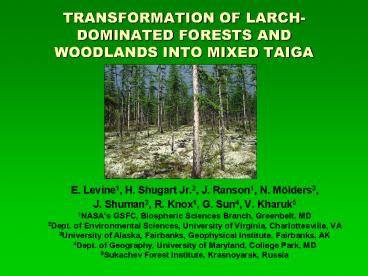TRANSFORMATION OF LARCH-DOMINATED FORESTS AND WOODLANDS INTO MIXED TAIGA PowerPoint PPT Presentation
Title: TRANSFORMATION OF LARCH-DOMINATED FORESTS AND WOODLANDS INTO MIXED TAIGA
1
TRANSFORMATION OF LARCH-DOMINATED FORESTS AND
WOODLANDS INTO MIXED TAIGA
- E. Levine1, H. Shugart Jr.2, J. Ranson1, N.
Mölders3, - J. Shuman2, R. Knox1, G. Sun4, V. Kharuk5
- 1NASAs GSFC, Biospheric Sciences Branch,
Greenbelt, MD - 2Dept. of Environmental Sciences, University of
Virginia, Charlottesville, VA - 3University of Alaska, Fairbanks, Geophysical
Institute, Fairbanks, AK - 4Dept. of Geography, University of Maryland,
College Park, MD - 5Sukachev Forest Institute, Krasnoyarsk, Russia
2
Northern Boreal forest/Taiga biome
3
Siberian Taiga
- One of the largest unaltered boreal forest areas
in the world making up 19- 20 of the worlds
forest area - Significant carbon sink estimated to store 74 Pg
C and 249 Pg C in the vegetation and soil,
respectively
- Long, severe winters (up to 6 months with mean
temperatures below freezing) and short summers
(50 to 100 frost-free days) - Annual temperature range -54C to 21C (-65F
to 70F ) - with occasional extremes 73C to 32 (-100F to
90F ) - mean annual precipitation 38 to 51 cm (15 to 20
in)
4
(No Transcript)
5
Major soils of the study area (US Soil Taxonomy)
(Cryosol Working Group, 2003)
6
Permafrost thickness (cm) in the study area
7
Siberian Larch (Larix sibirica)
- Deciduous needleleaf conifer native to Russia and
northern China that loses it foliage each fall - Occupies 270 million ha of boreal forest
- Siberian larch prefers light and is tolerant of
both heat and frost, allowing it to grow on
permafrost sites, where it is often found
8
A
R
U
S
S
I
R
U
S
S
I
A
9
- In Northern Siberia
- Average temperatures have risen 1 to 3C (3 to
5F) over the past 30 years, compared to the
worldwide average increase of 0.6C (1F) - Noticeable changes over the past few decades
include - increases in winter and fall precipitation
- winter warming
- higher soil temperatures
- permafrost thawing
- fires
- insect outbreaks
- ground subsidence
10
(No Transcript)
11
Some possible effects of permafrost thawing
- warming of the soil profile
- increased depth of active layer
- increased organic decomposition
- release of CO2 and methane
- change in soil moisture storage
- increased evaporation
- increased runoff
- change in forest species
- Increased wildfires
12
AREA 3
AREA 1
AREA 2
13
Objectives
- Use coupled forest gap and soil process models to
understand their process level interaction under
different scenarios - Identify the extent of the evergreen conifer
invasion using a combination of well-calibrated
satellite data and ground measurements - Use these tools to forecast trends of forest
species biodiversity in the region
14
Questions
- Are historical areas of larch dominance in
Siberia transforming into a zone of mixed taiga
in areas of disturbance? - Will the trees in this ecosystem begin to grow
faster and gradually extend their reach farther
north into the treeless tundra? - Will extensive changes in the larch dominated and
adjacent forests impact the carbon, energy, and
water cycles of Siberia? - Will hotter, drier conditions inhibiting growth
and leave the forest prone to invasive species
and wildfires?
15
VALIDATION
MODEL INITIALIZATION
COMBINED MODELING
- Remote Sensing
- Predicted pixel level attributes
- height
- biomass
- species composition
- LAI
- Field Measurements
- Detailed ground knowledge
- Forest Attributes
- Remote Sensing
- Maps
- Field measurements
- (e.g. forest type and structure, disturbance
history) - Soil Attributes
- Maps
- Field Measurements
- (e.g. soil texture, bulk density, and horizon
depths, moss thickness) - Climate
- Weather Station Data
- Warming and precipitation scenarios
- Forest Model
- (FAREAST)
- Species composition
- Stand structure
- Seed sources
- Others
RESULTS
- Soil Model
- (HSTVS)
- Soil moisture flux
- Soil temperature flux
- Snow and moss insulation
- Depth of active layer thaw
- Others
- Ecological Forecasts
- Projected species composition and structure
- Areal impacts
- Model results mapped to stratified landscapes
16
FAREAST A Boreal Forest Simulator
Yan, X. and Shugart, H.H. (2005) FAREAST a
forest gap model to simulate dynamics and
patterns of eastern Eurasian forests. Journal of
Biogeography, 321641-1658.
- Regeneration
- Available Light
- Soil Moisture
- Site Quality
- Depth of Thaw
- Seed Bed
- Seed Availability
- Sprouting
- Layering
- Growth
- Available Light
- Soil Moisture
- Site Quality
- Growing-Degree Days
- Depth of Thaw
- Diameter
- Age
- Height
- Mortality
- Stress
- Fire
- Insects
- Age
17
Krankina O.N., et al. 2005. Effects of climate,
disturbance, and species on forest biomass across
Russia. Can. J.For.Res. 35 2281-2293
18
Hydro-Thermodynamic Soil-Vegetation Simulation
(HTSVS) Mölders, N., U. Haferkorn, J. Döring, G.
Kramm, 2003 Long-term numerical investigations
on the water budget quantities predicted by the
hydro-thermodynamic soil vegetation scheme
(HTSVS) Meteorol. Atmos. Phys., 84, 115-135.
- Multi-layer soil model
- including peat, moss, and lichen
- Multi-layer snow model
- Includes simulations of
- heat conduction and water diffusion
- soil freezing and thawing and cross effects
- release and consumption of latent heat
- effects of frozen soil layers on vertical fluxes
of heat, moisture and water vapor flux
19
HSTVS Results
- Soil temperatures will be predicted more
accurately if frozen soil physics are considered - The soil model captures the observed seasonal
course of soil temperature well and moisture
acceptably - The largest uncertainty in simulated soil
temperature occurs around freezing - Results are sensitive to soil properties
- Time steps larger than 10 minutes no longer
captures the active layer effectively - Soil properties below 1meter are important
- 20 layers and a depth of -30m provide better
results
20
Tura field station, Siberia
21
(No Transcript)
22
(No Transcript)

